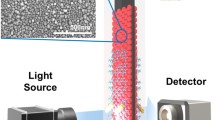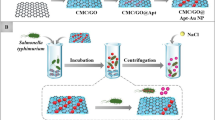Abstract
Photothermal effect of nanomaterial has been applied to the establishment of rapid detection method such as test strip. Previously, the detector for the photothermal test strip method mainly was a bulky thermal imaging camera or an infrared-sensing temperature sensor of which the detection data obtained is unstable due to its susceptibility to environmental changes. Herein, a resistive temperature sensor which is more stable and less susceptible to external environment was adopted. A test strip was used to detect Salmonella enterica Typhimurium (Salmonella typhimurium). The carboxylated graphene oxides (GOs), which have a more excellent photothermal effect, labeled with anti-Salmonella typhimurium antibodies, were used as a nanomarker to produce thermal signal. Subsequently, temperature variation signal (ΔT) generated by carboxylated GOs exposed to 808 nm laser was detected by conventional resistive temperature sensor directly. Under optimal conditions, a standard curve of ΔT with respect to the different numbers of Salmonella typhimurium was established, the detection limit was 104 CFU·mL-1 and the detection time was 20 min. The proposed detection method with high sensitivity, specificity, and efficiency can be used as a novel and on-site screening technology to detect Salmonella typhimurium in food, environmental, or clinical samples.





Similar content being viewed by others
References
Chen Y, Su Y, Hu S, Chen S (2016) Functionalized graphene nanocomposites for enhancing photothermal therapy in tumor treatment. Adv Drug Deliver Rev 105:190–204
Chin WH, Sun Y, Hogberg J, Quyue TL, Engelsmann P, Wollf A, Bang DD (2017) Direct PCR – A rapid method for multiplexed detection of different serotypes of Salmonella in enriched pork meat samples. Mol Cell 32:24–32
Du S, Wang Y, Liu Z, Xu Z, Zhang H (2019) A portable immune-thermometer assay based on the photothermal effect of graphene oxides for the rapid detection of Salmonella typhimurium. Biosens Bioelectron 144:111670
Fu L, Li S, Zhang K, Chen I, Petrenko VA, Cheng ZY (2007) Magnetostrictive microcantilever as an advanced transducer for biosensors. sensors 7:2929–2941
Gibbs PA, Patterson JT, Murray JG (2010) The fluorescent antibody technique for the detection of Salmonella in routine use. Appl Bacteriol 5:405–413
He S, Hai J, Sun S, Lu S, Wang B (2019) Palladium Coordination Polymers Nanosheets: New Strategy for Sensitive Photothermal Detection of H2S. Anal Chem 91:10823–10829
Jain S, Chattopadhyay S, Jackeray R, Abid CK, Kohli GS, Singh H (2012) Highly sensitive detection of Salmonella typhi using surface aminated polycarbonate membrane enhanced-ELISA. Biosens Bioelectron 31:37–43
Karash S, Liyanage R, Qassab A, Lay JO, Kwon YM (2017) A comprehensive assessment of the genetic determinants in salmonella typhimurium for resistance to hydrogen peroxide using proteogenomics. Sci Rep 7:17073
Kim G, Moon J, Moh C, Lim J (2015) A microfluidic nano-biosensor for the detection of pathogenic Salmonella. Biosens Bioelectron 67:243–247
Li C, Cordovilla F, Jagdheesh R, Ocana JL (2018) Design Optimization and Fabrication of a Novel Structural SOI Piezoresistive Pressure Sensor with High Accuracy. Sensors 18:439
Lu Y, Lin C, Yang H, Lin K, Wey S, Sun C, Wei K, Yen T, Lin C, Ma C, Chen J (2014) Biodistribution of PEGylated graphene oxide nanoribbons and their application in cancer chemo-photothermal therapy. Carbon 74:83–95
Maduraiveeran G, Sasidharan M, Ganesan V (2017) Electrochemical sensor and biosensor platforms based on advanced nanomaterials for biological and biomedical applications. Biosens Bioelectron 103:113–129
Nabaei V, Chandrawati R, Heidari H (2018) Magnetic biosensors: Modelling and simulation. Biosens Bioelectron 103:69–86
Park J, Yoon J, Kim Y, Lee T, Jeong G, Kim D, Bhang S (2019) Enhancing therapeutic efficacy of photothermal therapy using poloxamer-reduced graphene oxide and mesenchymal stem cells. J Ind Eng Chem 80:846–853
Qin Z, Chan WC, Boulware DR, Akkin T, Butler EK, Bischof JC (2012) Significantly improved analytical sensitivity of lateral flow immunoassays by using thermal contrast. Angew Chem Int Ed Engl 51:4358–4361
Rohde A, Hammerl J, Appel B, Dieckmann R, Dahouk S (2015) FISHing for bacteria in food – A promising tool for the reliable detection of pathogenic bacteria. Food Microbiol 46:395–407
Saroh N, Warakorn L, Apon N, Kanatharana P, Charlermroj R, Karoonuthaisiri N, Thavarungkul P (2018) Phage-based capacitive biosensor for Salmonella detection. Talanta 188:658–664
Shi J, Zhang F, Wu S, Guo Z, Huang X, Hu X, Holmes M, Zou X (2019) Noise-free microbial colony counting method based on hyperspectral features of agar plates. Food Chem 274:925–932
Wang D, Wang L, Zhu G, Yu W, Zeng J, Yu X, Xie H, Xian G, Li Q (2018) Magnetic Photothermal Nanofluids with Excellent Reusability for Direct Absorption Solar Collectors. ACS Appl Energy Mater 1:3860–3868
Wu X, Wang W, Liu L, Kuang H, Xu C (2015) Monoclonal antibody-based cross-reactive sandwich ELISA for the detection of Salmonella spp. in milk samples. Anal Methods 7:9047–9053
Xu Y, Luo Z, Chen J, Huang Z, Wang X, An H, Duan Y (2018) Ω-Shaped Fiber-Optic Probe-Based Localized Surface Plasmon Resonance Biosensor for Real-Time Detection of Salmonella Typhimurium. Anal Chem 90:13640–13646
Yu L, Li P, Ding X, Zhang Q (2017) Graphene oxide and carboxylated graphene oxide: Viable two-dimensional nanolabels for lateral flow immunoassays. Talanta 165:167–175
Zhang H, Zhang Z, Wang Y, Wu C, Li Q, Tang B (2016) Rapid and Sensitive Detection of Cancer Cells Based on the Photothermal Effect of Graphene Functionalized Magnetic Microbeads. ACS Appl Mater Inter 8:29933–29938
Zhang D, Du S, Su S, Wang Y, Zhang H (2019) Rapid detection method and portable device based on the photothermal effect of gold nanoparticles. Biosens Bioelectron 123:19–24
Funding
This work was supported by the National Natural Science Foundation of China (31871874).
Author information
Authors and Affiliations
Corresponding author
Ethics declarations
Conflict of Interest
Ying Wang, Shupeng Su, Shuyuan Du, Yu Gao, Zhixiang Xu, and Hongyan Zhang declare that they have no conflict of interest.
Ethical Approval
This article does not contain any studies with human participants or animals performed by any of the authors.
Additional information
Publisher’s Note
Springer Nature remains neutral with regard to jurisdictional claims in published maps and institutional affiliations.
Rights and permissions
About this article
Cite this article
Wang, Y., Su, S., Du, S. et al. Rapid Detection for Salmonella typhimurium by Conventional Resistive Temperature Sensor Based on Photothermal Effect of Carboxylated Graphene Oxide. Food Anal. Methods 13, 1755–1763 (2020). https://doi.org/10.1007/s12161-020-01793-5
Received:
Accepted:
Published:
Issue Date:
DOI: https://doi.org/10.1007/s12161-020-01793-5




